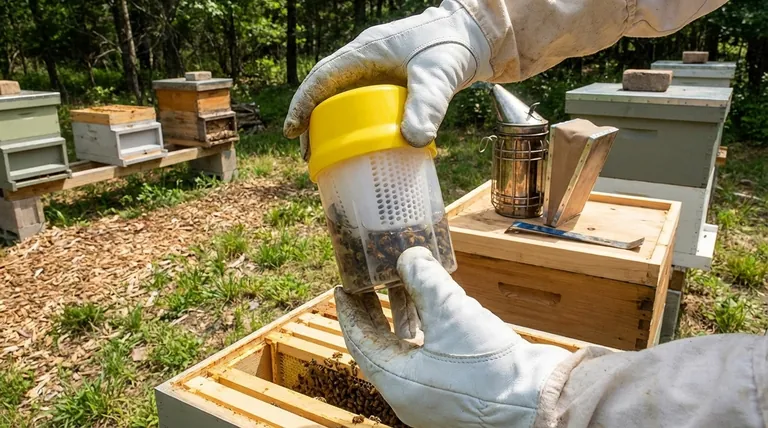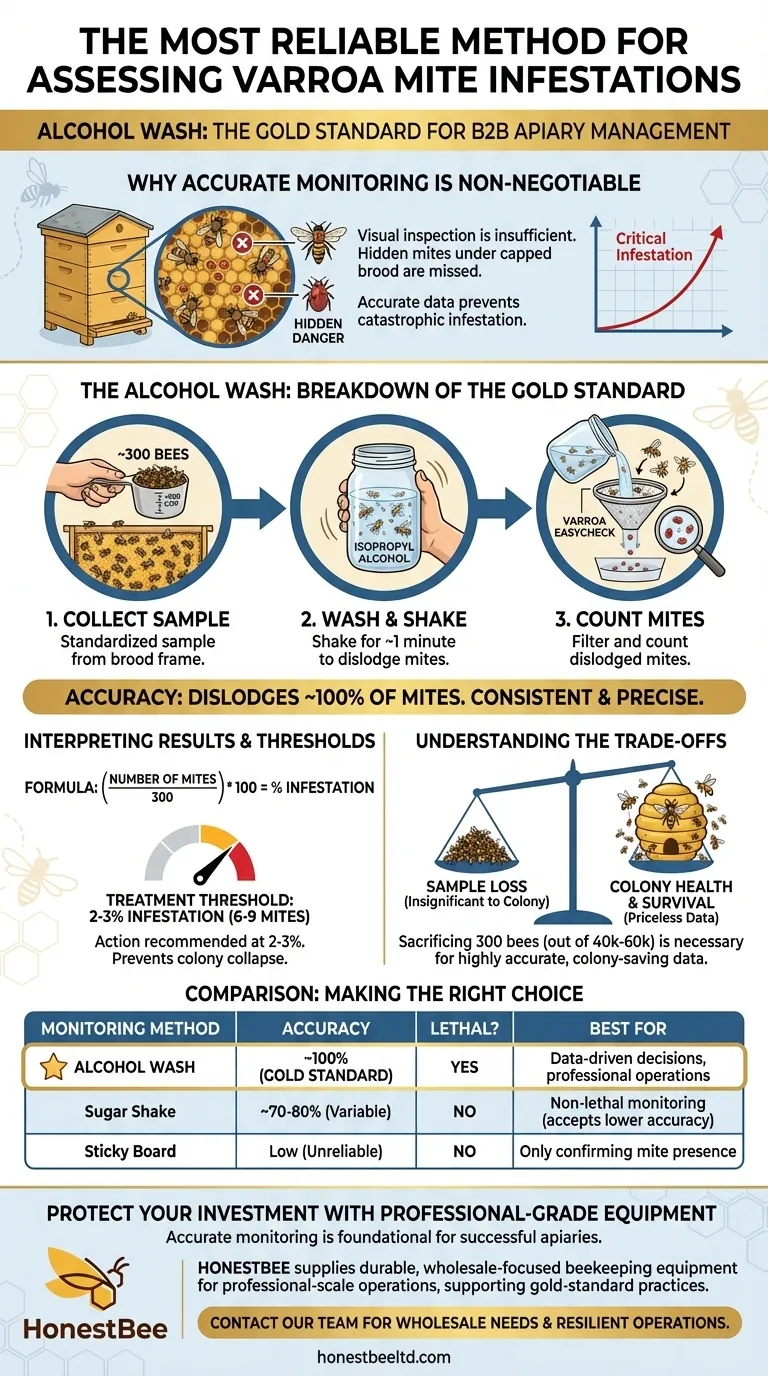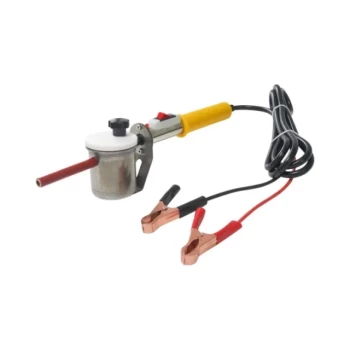For assessing Varroa mite infestations, the alcohol wash is the most accurate and reliable method available to beekeepers. It provides a clear, quantitative measure of your colony's mite load, which is essential for making timely and effective treatment decisions. This method has become the gold standard used by researchers and professional apiarists due to its consistency and precision.
While other methods exist, the alcohol wash removes the guesswork from Varroa monitoring. Its superior accuracy gives you the data needed to protect your hives before an infestation becomes catastrophic, making it the cornerstone of a proactive management strategy.

Why Accurate Monitoring is Non-Negotiable
A visual inspection of a colony is not enough to gauge the threat of Varroa mites. By the time you can easily see mites on the backs of bees, the infestation is likely already at a critical, and often irreversible, level.
The true danger lies with the mites reproducing under the capped brood, hidden from view. A reliable testing method gives you a window into this hidden population by measuring the mites attached to the adult bees.
This data allows you to apply treatments only when necessary and to verify that your treatments were successful, saving money and reducing chemical exposure in the hive. You cannot manage what you do not measure.
A Breakdown of the Gold Standard: The Alcohol Wash
The alcohol wash method is valued for its simplicity and repeatability. The results provide a clear "mite load" percentage that can be directly compared to established treatment thresholds.
How the Alcohol Wash Works
The process involves collecting a standardized sample of bees, typically a half-cup which is around 300 bees, from a frame containing brood. These bees are submerged in isopropyl (rubbing) alcohol and shaken for about a minute.
This action dislodges the phoretic mites from the bees' bodies. The liquid is then poured through a filter or a specialized device like the Varroa EasyCheck, which traps the bees but allows the much smaller mites to pass through to be counted.
The Key to Its Reliability
The alcohol wash is considered the most accurate method because it dislodges nearly 100% of the mites from the sampled bees. Unlike other methods, its effectiveness is not compromised by environmental factors like temperature or humidity.
This consistency ensures that when you test multiple hives, or the same hive over time, you are getting a true comparison of mite levels.
Interpreting the Results
The goal is to calculate the infestation rate as a percentage. To do this, you divide the number of mites you counted by the number of bees in your sample (typically 300), and then multiply by 100.
Formula: (Number of Mites / 300) * 100 = % Infestation
Most beekeeping experts recommend taking action when the mite load reaches a 2-3% infestation level (6-9 mites in a 300-bee sample). Waiting longer significantly increases the risk of colony collapse.
Understanding the Trade-offs
No method is without its compromises. The primary drawback of the alcohol wash is that the sample of bees is sacrificed. However, it's crucial to put this loss into perspective.
The Sacrifice of the Sample
A healthy colony in summer contains 40,000 to 60,000 bees, and the queen can lay over 1,500 eggs per day. The loss of 300 bees is a statistically insignificant number that has no impact on the colony's overall health or productivity.
This small sacrifice is a necessary trade-off for obtaining highly accurate data that can be used to save the entire colony from a Varroa-induced collapse.
Comparison with the Sugar Shake
The "sugar shake" method is the most common non-lethal alternative. It involves rolling bees in powdered sugar to dislodge mites. While it does not kill the bees, its accuracy is significantly lower and less consistent than an alcohol wash.
The effectiveness of a sugar shake can be influenced by ambient humidity, user technique, and the age of the sugar. It typically detects around 70-80% of the mites at best, meaning you may underestimate your mite load and fail to treat in time.
The Limitations of Sticky Boards
Counting the "natural mite drop" on a sticky board placed at the bottom of the hive is the least reliable method for making treatment decisions. It only measures mites that happen to fall off bees, which is a poor indicator of the total phoretic mite population.
A sticky board test can confirm the presence of mites but cannot provide the accurate infestation percentage needed to decide when to treat.
Making the Right Choice for Your Operation
Your choice of monitoring method should align directly with your management goals. Consistent, data-driven monitoring is the difference between reacting to a dying hive and proactively maintaining a healthy one.
- If your primary focus is maximum accuracy and data-driven decisions: The alcohol wash is the unequivocal best choice for reliable, repeatable results that inform treatment thresholds.
- If your primary focus is non-lethal monitoring: The sugar shake is a viable alternative, but you must accept its lower accuracy and be rigorous in your technique to avoid false negatives.
- If your primary focus is simply confirming mite presence: A sticky board can serve this limited purpose, but it should never be used to determine if a colony is below the treatment threshold.
Ultimately, choosing a reliable testing method and using it consistently is the most powerful action you can take to ensure the long-term health of your bees.
Summary Table:
| Monitoring Method | Accuracy | Lethal to Bees? | Best For |
|---|---|---|---|
| Alcohol Wash | ~100% (Gold Standard) | Yes | Data-driven decisions, professional operations |
| Sugar Shake | ~70-80% (Variable) | No | Non-lethal monitoring (accepts lower accuracy) |
| Sticky Board | Low (Unreliable) | No | Only confirming mite presence |
Protect Your Investment with Professional-Grade Equipment
Accurate Varroa mite monitoring is the foundation of a successful apiary. Equip your operation with the reliable tools needed for consistent, data-driven hive management.
HONESTBEE supplies commercial apiaries and beekeeping equipment distributors with the durable, wholesale-focused supplies required for professional-scale beekeeping. From Varroa EasyCheck kits to other essential gear, we provide the equipment that supports the gold-standard practices outlined in this article.
Ensure your colonies thrive. Contact our team today to discuss your wholesale equipment needs and build a more resilient, profitable operation.
Visual Guide

Related Products
- Varroa Easy Check Mite Tester Kit Counter Alcohol Wash Jar
- 12V Bee Mite Removal Evaporator Oxalic Acid Vaporizer for Bee Fumigation Treatment 180W Atomization
- Nicot Queen Rearing Kit for Beekeeping and Grafting in Nicot System
- Professional Plastic Queen Excluder for Modern Beekeeping
- Jenter Queen Rearing Kit Complete Set for Bee Breeding
People Also Ask
- What are the steps to perform an alcohol wash test after collecting the bees? A Guide to Accurate Varroa Mite Counting
- Why is an alcohol wash preferred over powdered sugar rolls? For Accurate Varroa Mite Management
- How does the Varroa EasyCheck determine mite counts? Achieve Accurate Hive Health Monitoring
- What is the Varroa EasyCheck and its purpose? Streamline Your Hive Health Monitoring
- What is the most accurate method for monitoring varroa mites? The Definitive Guide for Beekeepers



















